From Day Hikes to Backcountry Expeditions: Your Complete Equipment Roadmap
Whether you’re planning your first weekend camping trip of 2025 or preparing for a multi-day backpacking expedition, having the right outdoor gear can make the difference between an unforgettable adventure and a challenging ordeal.
The world of outdoor equipment can feel overwhelming with countless options, technical specifications, and gear categories to navigate.
This latest OTL guide will help you understand what equipment you truly need, how to choose quality gear that fits your specific activities, and how to build a versatile outdoor kit that grows with your adventures.
From essential safety equipment to comfort-enhancing accessories, we’ll cover everything you need to know to gear up confidently for your next outdoor experience.
Understanding Your Outdoor Activity Needs
Before diving into specific gear recommendations, it’s crucial to understand that different outdoor activities require different equipment approaches.
Your gear needs will vary significantly depending on whether you’re planning day hikes, overnight camping trips, multi-day backpacking adventures, or specialized activities like rock climbing or water sports.
Day hiking typically requires minimal gear focused on safety, navigation, and comfort during 4-8 hour excursions.
You’ll need lightweight, compact equipment that won’t weigh you down but will keep you prepared for changing conditions.
Overnight camping allows for heavier, more comfortable gear since you’re establishing a base camp rather than carrying everything on your back all day.
Backpacking demands the most careful gear selection, as every ounce matters when you’re carrying your entire kit for miles.
Multi-day expeditions require durable, reliable equipment that can withstand extended use in challenging conditions.
Specialized activities like mountaineering, rock climbing, or water sports have unique gear requirements that go beyond basic outdoor equipment.
Consider your local climate, typical weather patterns, and the specific environments where you’ll be adventuring.
Desert hiking requires different gear than mountain backpacking, and coastal camping presents different challenges than forest exploration.
The Essentials: Core Gear for Every Adventure
Regardless of your specific outdoor activity, certain categories of gear form the foundation of any well-equipped adventurer’s kit.
These essentials focus on safety, navigation, shelter, and sustenance.
Navigation Tools: GPS vs. Map & Compass
Modern navigation combines traditional and technological approaches for maximum reliability.
GPS devices and smartphone apps provide precise location data and route tracking, but they depend on battery power and satellite signals that can be interrupted by weather or terrain.
Map and compass navigation represents time-tested reliability that doesn’t depend on batteries or signals.
Quality topographic maps show terrain features, elevation changes, and landmarks that help you understand your surroundings beyond just your location.
A reliable compass provides directional reference even when visibility is limited.
The best approach combines both methods. Use GPS technology for convenience and detailed tracking, but always carry physical maps and a compass as backup.
Learn basic navigation skills before heading into unfamiliar territory, and practice using both traditional and modern tools.
- Explore confidently with the reliable handheld GPS
- 2.2″ sunlight-readable color display with 240 x 320 display pixels for improved readability
- Preloaded with Topo Active maps with routable roads and trails for cycling and hiking
First Aid Kits: Be Prepared
A well-stocked first aid kit is non-negotiable for any outdoor adventure.
Pre-assembled kits provide a good foundation, but customizing your kit based on your specific activities, group size, and medical knowledge creates the most effective emergency preparation.
Basic first aid supplies should include adhesive bandages in various sizes, gauze pads and medical tape, antiseptic wipes, pain relievers, and any personal medications.
For longer trips or more remote adventures, consider adding items like blister treatment, elastic bandages, emergency blankets, and water purification tablets.
Equally important is knowing how to use everything in your kit. Take a wilderness first aid course to learn essential skills like wound cleaning, treating sprains, recognizing signs of hypothermia, and when to seek emergency evacuation.
- Lightweight Emergency Kit: This ultralight medical kit fits easily in your pack’s side pocket for convenient access; inc…
- Durable DryFlex Bag: The durable first aid kit also features a reusable, waterproof DryFlex inner bag that keeps the sup…
- First Aid Essentials: Our wound care kit includes bandages, gauze, and medications to address common outdoor injuries
Shelter Systems: Protection from the Elements
Shelter encompasses everything from clothing layers to emergency bivouacs to full camping setups.
The key is matching your shelter system to your activity duration, expected weather conditions, and weight considerations.
Emergency shelters like space blankets or bivvy sacks provide critical protection during unexpected weather changes or emergency situations.
These lightweight options should be part of every outdoor kit, even for day trips.
For overnight adventures, tents provide the most comprehensive protection.
Three-season tents handle most conditions encountered during spring, summer, and fall, while four-season tents are built for winter conditions and extreme weather.
Consider factors like interior space, ventilation, ease of setup, and packed weight when choosing a tent.
Sleeping systems including sleeping bags and pads create your personal microclimate for rest and recovery.
Sleeping bags are rated for specific temperature ranges, and understanding these ratings helps you choose appropriate warmth for your adventures.
Sleeping pads provide insulation from ground cold and cushioning for comfort.
- Ultra-Lightweight & Compact: Naturehike Cloud-Up 2-Person Tent sets the bar high for hiking gear with its super lightwei…
- Premier Quality & Waterproof: Crafted with the finest materials, our tent offers maximum durability. The inner layer, ma…
- Simple Setup & Pack Down: With a design focused on user-friendliness, the Cloud-Up tent can be set up and packed down in…
Hydration: Water Sources and Purification
Staying properly hydrated is fundamental to outdoor performance and safety.
Plan for adequate water capacity based on your activity duration, intensity, and environmental conditions. Hot weather, high altitude, and strenuous activity all increase hydration needs.
Water bottles and hydration reservoirs each offer advantages. Bottles are easier to monitor consumption and refill, while reservoirs provide hands-free drinking during activities.
Many adventurers use both systems for maximum flexibility.
Water purification becomes essential when natural water sources are your only option.
Filtration systems remove bacteria and parasites, while purification tablets or UV sterilizers eliminate viruses.
Boiling water is the most reliable purification method when you have the time and fuel.
- HIGH-PERFORMANCE FILTER: The BeFree’s 0.1 micron hollow fiber microfilter is tested to protect against harmful organisms…
- ULTRALIGHT & COMPACT: Ultralight at just 2.3 oz. (63 grams) The collapsible Hydrapak Soft-Flask allows for portability i…
- EASY TO CLEAN: The Stay Clean drink nozzle protects against dirt, debris, and bacteria between uses. Simply shake or swi…
Gear Spotlight: Must-Haves for Day Hiking
Day hiking represents the most accessible form of outdoor adventure, requiring gear that balances functionality with minimal weight.
Your day hiking kit should prepare you for weather changes, minor injuries, and navigation challenges while remaining comfortable to carry.
A quality day pack provides organization and comfort for carrying your essentials.
Look for packs with padded shoulder straps, chest and hip belts for load distribution, and external attachment points for gear like trekking poles or water bottles.
Capacity between 20-30 liters typically provides adequate space for day hiking essentials.
Proper footwear forms the foundation of hiking comfort and safety.
Trail shoes offer lightweight performance for maintained trails and day hikes, while hiking boots provide additional ankle support and protection for rugged terrain.
Consider your typical hiking conditions, personal ankle stability, and comfort preferences when choosing footwear.
Weather protection includes layers for temperature regulation and rain gear for sudden storms.
A lightweight rain jacket and pants can be lifesavers during unexpected weather changes.
Sun protection through hats, sunglasses, and sunscreen becomes increasingly important at higher elevations where UV exposure intensifies.
Choosing the Right Backpacks
Selecting the perfect backpack involves balancing capacity, fit, features, and weight for your specific needs.
Backpack capacity is measured in liters, with day packs ranging from 15-35 liters, weekend packs from 35-50 liters, and extended backpacking packs from 50+ liters.
Backpack Capacity & Fit
Proper fit is more important than features or brand reputation.
A well-fitting pack distributes weight evenly between your hips and shoulders, reducing fatigue and preventing injury.
Most quality packs come in multiple sizes based on torso length, not overall height.
Key fit elements include hip belt positioning, shoulder strap comfort, and load adjustment straps.
The hip belt should sit on your hip bones, not your waist, and carry 70-80% of the pack’s weight.
Shoulder straps should curve naturally over your shoulders without gaps or pressure points.
Load adjustment features like load lifter straps, compression straps, and sternum straps help fine-tune fit and stability.
These features become increasingly important as pack weight increases or terrain becomes more challenging.
Features and Organization
Modern backpacks include numerous features designed to improve organization, access, and functionality.
Consider which features align with your specific needs rather than choosing packs with the most features.
Access options include top-loading designs with drawstring closures, panel-loading designs that open like suitcases, and hybrid designs combining both approaches.
Panel-loading provides easier access to gear but may be less weather-resistant. Top-loading designs excel in weather protection and weight distribution.
Organizational features like internal pockets, external attachment points, and compression zippers help keep gear accessible and secure.
However, more features often mean more weight and higher cost, so prioritize features you’ll actually use.
- NOT YOUR BASIC BACKPACK: Feature rich at this price point; Comfort and balanced backpack for men and women.
- TETON TOUGH: The best memories are made with the great durable gear; Perfect for any Adventure; comes in 45L, 55L or 65L…
- CUSTOM COMFORT: Multi position torso adjustment fits medium and tall adventurers; Durable open-cell foam lumbar pad and …
Footwear: Boots vs. Trail Shoes
The choice between hiking boots and trail shoes depends on your hiking style, terrain, personal preferences, and ankle stability needs.
Both options have evolved significantly, with modern materials and construction techniques improving performance across categories.
Hiking Boots: Support and Protection
Traditional hiking boots provide maximum ankle support, protection from rocks and debris, and durability for challenging terrain.
Modern boots use lighter materials and improved construction techniques, reducing the weight penalty while maintaining support benefits.
Boot height varies from mid-cut designs that provide moderate ankle support to high-cut boots offering maximum protection.
Higher boots provide more support but can feel restrictive and may require longer break-in periods.
Waterproof boots keep feet dry in wet conditions but can lead to overheating and moisture buildup during intensive activities.
Non-waterproof boots offer better ventilation but require careful consideration of weather conditions and stream crossings.
Trail Shoes: Lightweight Performance
Trail shoes prioritize lightweight construction, flexibility, and comfort for maintained trails and day hiking.
Modern trail shoes provide surprising durability and protection while maintaining the comfort and natural feel of athletic shoes.
Aggressive tread patterns provide traction on various surfaces, while protective features like rock plates shield feet from sharp objects.
Many trail shoes now include water-resistant treatments that provide protection without the breathability sacrifice of fully waterproof construction.
The choice between boots and shoes often comes down to personal preference, hiking style, and specific terrain requirements.
Many hikers own both types, choosing based on specific trip requirements.
- Performance suede leather and mesh upper
- Bellows, closed-cell foam tongue keeps moisture and debris out
- Merrell air cushion in the heel absorbs shock and adds stability
Tents: Types and Features
Tent selection involves balancing weight, space, weather protection, and ease of setup for your specific camping needs.
Camping tents and backpacking tents are super popular in our messages and questions asked!
Understanding tent designs and features helps you choose the right shelter for your adventures.
Tent Categories and Designs
Three-season tents handle spring, summer, and fall conditions in most climates.
They prioritize ventilation, weight savings, and versatility over extreme weather protection.
Most recreational camping and backpacking uses three-season tents.
Four-season tents are built for winter conditions, extreme weather, and mountaineering.
They feature stronger materials, more robust construction, and better snow load capacity but sacrifice ventilation and weight for extreme weather protection.
Ultralight tents push weight savings to minimum levels, often requiring trekking poles or other equipment for setup.
These tents excel for long-distance backpacking where every ounce matters but may sacrifice durability and comfort.
Setup and Usability Features
Tent setup complexity varies dramatically between designs.
Freestanding tents can be set up without stakes, providing flexibility in campsite selection and easier setup on hard surfaces.
Non-freestanding tents require proper staking but often offer better space efficiency and weight savings.
Interior space efficiency affects comfort during extended stays.
Tent designs maximize usable space through wall angles, vestibule areas, and gear storage solutions.
Consider how you’ll use interior space for sleeping, gear storage, and weather protection.
Ventilation features prevent condensation buildup and maintain comfort during warm weather.
Multiple mesh panels, adjustable vents, and rainfly designs all contribute to airflow management.
- 【Durable and High-Quality Material】: BISINNA Camping tent are made with high quality Material. The INNER TENT made with …
- 【Roomy 2-person Tent for 3 Seasons】: With the unfolding size of (23.6+55+23.6) x 82.7 x 47.2 (H) inches / (60+140+60) x …
- 【Breathable & Stable】: Large section of mesh and 2 D-shaped doors with dual zippers provide much better ventilation. Equ…
Sleeping Systems: Bags & Pads
Quality sleep is essential for outdoor performance and enjoyment.
Sleeping systems encompass sleeping bags, sleeping pads, and pillows working together to provide warmth, comfort, and rest.
Sleeping Bag Selection
Sleeping bag temperature ratings indicate the lowest temperature where the bag will keep you warm.
However, these ratings vary between manufacturers and individual cold tolerance.
Choose bags rated 10-15 degrees below the coldest temperatures you expect to encounter.
Insulation types include down and synthetic materials, each with advantages and disadvantages.
Down provides superior warmth-to-weight ratio and compressibility but loses insulation properties when wet.
Synthetic insulation maintains warmth when damp and dries quickly but weighs more and compresses less.
Bag shape affects warmth, weight, and comfort.
Mummy bags provide maximum warmth efficiency through close-fitting designs but can feel restrictive.
Rectangular bags offer more room to move but sacrifice warmth efficiency. Semi-rectangular designs balance warmth and comfort.
- 3-Season Design: Mummy styled sleeping bag for spring, summer, and fall, offering warmth and comfort for 46.4~59°F (8~15…
- Water Repellent: 300T pongee outer shell, 190T pongee lining, 7oz polycotton filling, offering excellent material streng…
- Snag-free Zippers: Quality YKK zippers with an anti-snag design and cord-stopped hood for better protection against the …
Sleeping Pad Importance
Sleeping pads provide insulation from ground cold and cushioning for comfort.
Ground contact conducts body heat away 25 times faster than air, making sleeping pads essential even in warm weather.
Pad insulation is measured by R-value, with higher numbers indicating better insulation.
R-values from 1-2 work for warm weather, 3-4 handle three-season conditions, and 5+ provide winter insulation.
Pad types include closed-cell foam, air-filled, and self-inflating designs.
Foam pads are durable and reliable but bulky. Air pads are lightweight and comfortable but vulnerable to punctures. Self-inflating pads balance comfort, insulation, and convenience.
- SLEEP COMFORT ALL NIGHT: Affordable lightweight camping pad with V-chamber design to limit air movement and heat loss fo…
- EASY-TO-USE valve allows for quick inflation and deflation of the Static V sleeping pad
- INCREDIBLY LIGHTWEIGHT: Packed Weight: 18. 6 Ounces; Packed Size: 3 x 8 Inches; Made of durable and rugged 75D polyester…
Layering Systems: Base, Mid, Outer
Effective layering manages body temperature, moisture, and comfort across changing conditions and activity levels.
Understanding layering principles helps you choose appropriate clothing for any outdoor adventure.
Base Layer Functions
Base layers manage moisture and provide basic insulation next to your skin.
Effective base layers move sweat away from your body, dry quickly, and maintain insulation properties when damp.
Material choices include merino wool, synthetic fabrics, and silk. Merino wool naturally resists odors, provides warmth when wet, and offers temperature regulation.
Synthetic materials excel in moisture management, durability, and quick drying.
Silk provides luxury comfort and packability but offers less durability.
Base layer fit should be snug but not restrictive, allowing proper moisture transfer while maintaining comfort during movement.
Avoid cotton base layers, which retain moisture and lose insulation when wet.
Mid Layer Insulation
Mid layers provide primary insulation and can be adjusted based on activity level and conditions.
Effective mid layers trap warm air while allowing moisture transfer from base layers.
Fleece mid layers offer warmth, breathability, and quick drying. They work well during high-output activities and provide good value for recreational outdoor use.
Down mid layers provide superior warmth-to-weight ratios for cold conditions but lose insulation when wet.
Synthetic insulation mid layers maintain warmth when damp and dry quickly, making them ideal for wet conditions or high-output activities.
Softshell jackets combine weather protection with insulation for versatile performance.
Outer Layer Protection
Outer layers protect against wind, rain, and snow while allowing moisture transfer from inner layers.
Effective outer layers balance weather protection with breathability for comfort during activity.
Hardshell jackets provide maximum weather protection through waterproof, breathable materials.
They excel in severe weather but can feel clammy during high-output activities. Softshell jackets offer weather resistance with better breathability for active pursuits.
Rain gear requires balancing weather protection, breathability, weight, and packability.
Lightweight rain jackets provide emergency protection, while robust rain suits handle extended exposure to severe weather.
- Waterproof Excellence: Embrace the rain with our men’s rain jacket, featuring superior Watertight Ⅳ technology. This rai…
- Breathable Comfort: Crafted from 100% Polyester, our raincoat for men delivers unparalleled breathability and lightweigh…
- Customizable Warmth: Experience tailored comfort with an adjustable drawstring hood that neatly tucks away, and a detach…
Cooking Systems & Food Storage
Outdoor cooking systems provide hot meals and beverages that improve comfort, morale, and nutrition during adventures.
System choice depends on group size, menu complexity, fuel availability, and weight considerations.
Stove Types and Fuel Options
Canister stoves use pressurized fuel canisters and provide consistent, controllable heat output.
They’re easy to use, light weight, and work well for simple cooking tasks.
However, fuel canisters can be expensive and difficult to dispose of properly.
Liquid fuel stoves burn white gas, kerosene, or gasoline and work well in cold conditions where canister stoves struggle.
They’re more complex to operate but provide better fuel efficiency and availability in remote areas.
Alternative fuel stoves burn wood, alcohol, or solid fuel tablets.
These systems reduce fuel weight for long trips but may be prohibited in fire-restricted areas and require more time and attention for cooking.
- Camping stove bundle includes CampStove 2+, Portable Grill, KettlePot, Coffee Press, FlexLight, 2x stuff sacks, micro US…
- Fueled by renewable biomass fuel such as twigs, sticks, pinecones, and other forest floor debris to book and boil water;…
- Devices can be charged via the integrated USB port; thermoelectric generator generates 3 watts of power for real-time ch…
Food Storage and Safety
Proper food storage prevents spoilage, protects against wildlife, and maintains nutrition during outdoor adventures.
Storage methods depend on trip duration, climate, and local wildlife considerations.
Bear-resistant food storage is required in many areas and recommended everywhere.
Hard-sided bear canisters provide maximum protection but add weight and bulk.
Bear bags and rope systems offer lighter alternatives but require proper technique and suitable trees.
Food selection balances nutrition, weight, preparation time, and storage requirements.
Dehydrated meals provide convenience and nutrition but cost more than preparing your own trail meals.
Fresh foods work well for short trips but require careful planning for longer adventures.
- EMERGENCY FOOD SUPPLY – Designed to provide 1,706 calories per day for 72 hours. 12 Cups of water is needed to prepared …
- NO ARTIFICIAL FLAVORS OR COLORS – Made with no artificial flavors or colors. Meals included: (1) Biscuits & Gravy, (2) G…
- QUICK PREP – Just add hot water to the pouch & eat in less than 10 minutes. Power outage? No problem. Mountain House mea…
Seasonal Gear Considerations
Different seasons present unique challenges and opportunities for outdoor adventures. Adapting your gear selection to seasonal conditions improves safety, comfort, and enjoyment.
Spring Outdoor Gear
Spring conditions are notoriously unpredictable, with rapid weather changes, muddy trails, and varying temperatures. Gear selection should emphasize versatility and weather protection.
Layering becomes crucial for managing temperature swings from cold mornings to warm afternoons.
Pack extra insulation layers and weather protection even for seemingly mild conditions.
Waterproof footwear and gaiters help manage muddy trails and stream crossings.
Bug protection starts becoming important as insects emerge.
Lightweight bug shirts, head nets, and insect repellent help maintain comfort during prime outdoor seasons.
Summer Adventure Equipment
Summer offers the most comfortable outdoor conditions but presents unique challenges like heat management, sun protection, and thunderstorm preparedness.
Lightweight, breathable clothing helps manage heat while providing sun protection.
Light-colored clothing reflects heat, while UPF-rated fabrics provide measurable sun protection.
Wide-brimmed hats and quality sunglasses protect face and eyes from intense UV exposure.
Increased water needs require larger hydration capacity or more frequent resupply opportunities.
Electrolyte replacement becomes important during hot weather activities.
Lightweight shelters with maximum ventilation provide comfort during warm nights.
Fall Gear Transitions
Fall combines beautiful conditions with increasing weather variability. Shorter days require reliable lighting, while temperature drops demand appropriate insulation.
Headlamps and flashlights become essential as daylight hours decrease.
Extra batteries and backup lighting prevent potentially dangerous situations.
Brighter colors improve visibility during hunting seasons in many areas.
Insulation needs increase as temperatures drop, but conditions may still be too warm for full winter gear.
Layering systems provide the flexibility to adapt to changing conditions throughout the day.
Winter Specialized Equipment
Winter outdoor activities require specialized gear designed for snow, ice, and extreme cold. Safety margins become more critical as conditions become less forgiving.
Insulation systems must handle extreme cold while managing moisture from physical activity.
Vapor barrier systems, expedition-weight insulation, and proper extremity protection become essential for cold weather safety.
Traction devices like microspikes or crampons provide safety on icy trails.
Avalanche safety equipment including beacons, probes, and shovels are essential for backcountry winter travel in avalanche terrain.
Maintaining Your Outdoor Equipment
Proper gear maintenance extends equipment life, maintains performance, and prevents field failures.
Regular maintenance is more cost-effective than gear replacement and more reliable than hoping equipment works when you need it.
Cleaning and Storage
Regular cleaning removes dirt, oils, and contaminants that degrade materials and performance.
Different materials require specific cleaning approaches to maintain their properties.
Technical fabrics often require specialized cleaners that maintain water-repellent treatments and breathability.
Regular detergents can strip treatments and reduce performance. Follow manufacturer recommendations for cleaning frequency and methods.
Proper storage prevents damage from moisture, pests, and UV exposure. Storing gear in cool, dry locations extends life significantly.
Avoid storing equipment in compressed states, which can damage insulation and reduce effectiveness.
Repair and Maintenance Skills
Basic repair skills prevent minor issues from ending adventures. Carrying simple repair supplies and knowing how to use them provides field solutions for common problems.
Tent and fabric repairs using patches and seam sealers address common damage.
Stove maintenance including cleaning and parts replacement keeps cooking systems reliable.
Boot care including cleaning, conditioning, and resoling maintains footwear performance.
Learning to recognize when professional repair or replacement is needed prevents equipment failures in critical situations.
Some repairs require specialized tools and expertise that exceed field capabilities.
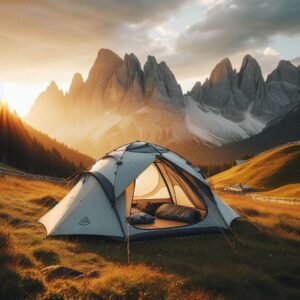
Sustainable and Eco-Friendly Gear Choices
Environmental responsibility in gear selection reflects the outdoor community’s commitment to protecting the spaces we love to explore.
Sustainable gear choices consider manufacturing impacts, durability, and end-of-life disposal.
Durable Gear Investment
High-quality, durable gear provides better long-term value and environmental benefits than frequently replaced cheaper alternatives.
Durable gear typically offers better performance, safety, and reliability while reducing waste.
Consider total cost of ownership including purchase price, maintenance costs, and replacement frequency.
Expensive gear often provides better value when used regularly over many years.
Modular gear systems allow upgrading components without replacing entire systems.
This approach provides flexibility while reducing waste and cost.
Responsible Manufacturing
Many outdoor companies now prioritize sustainable manufacturing practices, using recycled materials, reducing waste, and supporting fair labor practices.
Researching company practices helps support responsible manufacturers.
Recycled materials in outdoor gear have improved dramatically in performance and durability.
Recycled polyester, nylon, and down provide performance comparable to virgin materials while reducing environmental impact.
Repair and warranty programs support gear longevity while reducing waste.
Companies offering repair services, spare parts, and generous warranties demonstrate commitment to gear longevity.
Leave No Trace Principles
Gear choices support Leave No Trace principles through minimal impact designs and responsible use practices.
Selecting appropriate colors, materials, and features helps minimize environmental impact.
Neutral colors blend with natural environments and reduce visual impact.
Avoid bright colors except for safety equipment where visibility is essential.
Minimal packaging and bulk reduce waste in manufacturing and transport.
Multipurpose gear reduces the total amount of equipment needed while maintaining functionality.
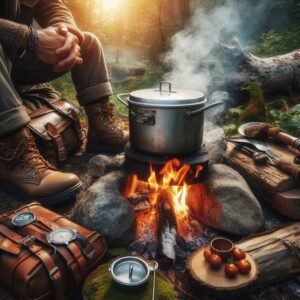
OTL Bottom Line on Outdoor Equipment
Selecting the right outdoor gear is a journey that evolves with your experience, interests, and adventures.
The key to building an effective outdoor kit lies in understanding your specific needs, prioritizing safety and comfort, and choosing quality equipment that will serve you reliably across many adventures.
Please keep in mind that the best gear is what you know how to use effectively.
Take time to learn your equipment, practice with it in controlled environments, and maintain it properly.
Start with essential safety items and basic comfort gear, then expand your kit as your skills and interests develop.
The outdoor community thrives on shared knowledge and experience.
Don’t hesitate to ask experienced adventurers for advice, read gear reviews, and learn from others’ experiences.
Most importantly, get outside and start exploring. The best outdoor education comes from actual experience in the field.
Quality gear opens doors to incredible adventures and helps you explore the natural world safely and comfortably.
Whether you’re planning your first camping trip or your hundredth backpacking adventure, the right equipment helps you focus on what matters most: experiencing the beauty, challenge, and renewal that outdoor adventures provide.
Start your adventure today, and remember that every expert was once a beginner. The mountains, forests, and wild places are waiting for you to explore them responsibly and safely.

Outdoor Gear FAQ
How much should I spend on my first outdoor gear setup?
Start with essential safety items and basic comfort gear, budgeting $300-600 for a complete day hiking setup including pack, footwear, and safety equipment.
Invest more in items you’ll use frequently like footwear and packs, while starting with budget options for specialty items until you understand your preferences.
What’s the most important piece of outdoor gear to invest in first?
Proper footwear is your most critical investment.
Quality hiking shoes or boots prevent injuries, provide comfort during long days, and directly impact your outdoor enjoyment.
Follow this with a well-fitting backpack and reliable navigation tools.
How do I know what size backpack I need?
Backpack size depends on trip length and personal packing style.
Day hikes: 15-30 liters, weekend trips: 30-50 liters, week-long backpacking: 50-70 liters.
Consider your torso length for proper fit, not your height.
Is expensive gear always better?
Not necessarily. Focus on gear that matches your activity level and conditions.
Expensive gear often provides marginal improvements that matter more to frequent users.
Prioritize fit, functionality, and reliability over premium features you won’t use.
How often should I replace my outdoor gear?
Replace gear when it no longer performs safely or effectively.
Quality boots last 500-1000 miles, tents can last 10+ years with proper care, and backpacks often last decades.
Regular maintenance extends gear life significantly.
What gear do I need for my first overnight camping trip?
Essential overnight gear includes shelter (tent), sleeping system (bag and pad), cooking equipment, headlamp, first aid kit, navigation tools, appropriate clothing layers, and food storage.
Start with car camping to test gear before backpacking.
How do I choose gear for different climates?
Research your destination’s typical weather patterns, elevation changes, and seasonal conditions.
Layer systems work in most climates, while specific items like insulated boots or sun hats address climate-specific challenges.
Should I buy gear online or in stores?
Try gear in-store when possible, especially for fit-critical items like boots and backpacks.
Online outdoor equipment shopping offers better selection and prices, but ensure good return policies for fit and performance issues.
Additional Resources
For official outdoor safety guidelines and land management information:
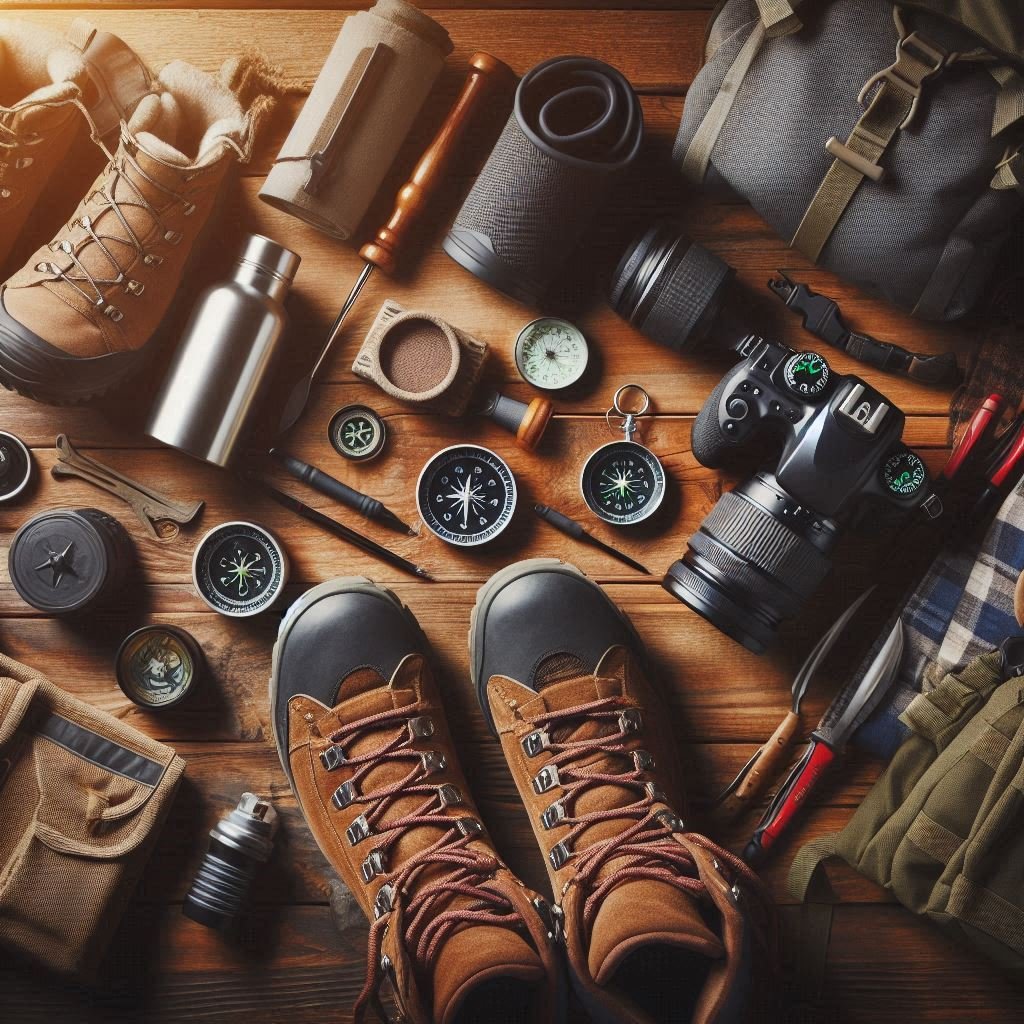
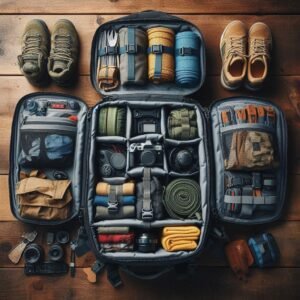













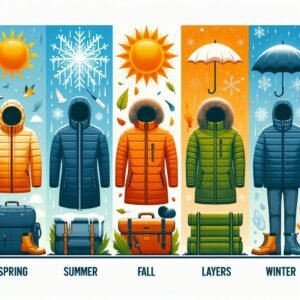
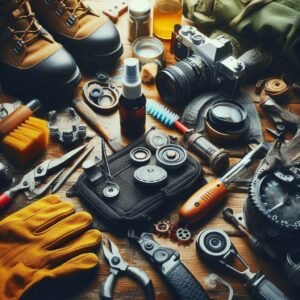
Leave a Reply